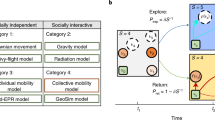Abstract
A nonlinear analysis of urban evolution is made by using of spatial autocorrelation theory. A first-order nonlinear autoregression model based on Clark’s negative exponential model is proposed to show urban population density. The new method and model are applied to Hangzhou City, China, as an example. The average distance of population activities, the auto-correlation coefficient of urban population density, and the auto-regressive function values all show trends of gradual increase from 1964 to 2000, but there always is a sharp first-order cutoff in the partial autocorrelations. These results indicate that urban development is a process of localization. The discovery of urban locality is significant to improve the cellular-automata-based urban simulation of modeling spatial complexity.
Similar content being viewed by others
References
Anderson P W, 1958. The absence of diffusion in certain random lattices. Physical Review, 109: 1492–1505.
Anderson P W, 1991. Is complexity physics? Is it science? What is it? Physics Today, 44(7): 9–11.
Batty M, 2000. Less is more, more is different: complexity, morphology, cities, and emergence. Environment and Planning B: Planning and Design, 27: 167–168.
Batty M, Couclelis H, Eichen M, 1997. Urban systems as cellular automata. Environment and Planning B: Planning and Design, 24: 159–164.
Batty M, Longley P A, 1994. Fractal Cities: A Geometry of Form and Function. London: Academic Press.
Bendiksen O O, 2000. Localization phenomena in structural dynamics. Chaos, Solitons and Fractals, 11: 1621–1660.
Bossomaier T, Green D, 1998. Patterns in the Sand: Computers, Complexity and Life. Massachusetts: Perseus Books.
Chen Yanguang, 2000. Derivation and generalization of Clark’s model on urban population density using entropy-maximising methods and fractal ideas. Journal of Central China Normal University (Natural Science Edition), 34(4): 489–492. (in Chinese)
Chen Yanguang, Liu Jisheng, 2006. Power spectral analyses of spatial auto-correlations of urban density: An application to the Hangzhou Metropolis. Advances in Earth Science, 21(1): 1–9. (in Chinese)
Clark C, 1951. Urban population densities. Journal of Royal Statistical Society, 114: 490–496.
El Naschie M S, 2000. Foreword: A very brief history of localization. Chaos, Solitons and Fractals, 11: 1479–1480.
Feng Jian, 2002. Modeling the spatial distribution of urban population density and its evolution in Hangzhou. Geographical Research, 21(5): 635–646. (in Chinese)
Feng Jian, 2004. Reconstruction of Urban Internal Space in China in the Transition Period. Beijing: Science Press. (in Chinese)
Hao Bailin, 1999. Characterization of complexity and ‘complexity science’. Science, 51(3): 3–8. (in Chinese)
Harvey D, 1971. Explanation in Geography. London: Edward Arnold Ltd.
Liu Jisheng, Chen Yanguang, 2002. GIS-based cellular automata models and researches on spatial complexity of man-land relationship. Geographical Research, 21(2): 155–162. (in Chinese)
Thompson J M T, Virgin L N, 1988. Spatial chaos and localization phenomena in nonlinear elasticity. Physical Letter A, 126: 491–496.
Torrens P M, O’sullivan D, 2001. Cellular automata and urban simulation: where do we go from here? Environment and Planning B: Planning and Design, 28: 163–168.
Walters P, 2000. An Introduction to Ergodic Theory. New York: Springer-Verlag.
White R, Engelen G, 1993a. Cellular dynamics and GIS: modeling spatial complexity. Geographical Systems, 1: 237–253.
White R, Engelen G, 1993b. Cellular automata and fractal urban form: a cellular modeling approach to the evolution of urban land-use patterns. Environment and Planning A, 25: 1175–1199.
Wilson A G, 2000. Complex Spatial Systems: The Modelling Foundations of Urban and Regional Analysis. Singapore: Pearson Education.
Author information
Authors and Affiliations
Corresponding author
Additional information
Foundation item: Under the auspices of the National Natural Science Foundation of China (No. 40371039)
Rights and permissions
About this article
Cite this article
Liu, J., Chen, Y. Spatial autocorrelation and localization of urban development. Chin. Geograph.Sc. 17, 34–39 (2007). https://doi.org/10.1007/s11769-007-0034-9
Received:
Accepted:
Issue Date:
DOI: https://doi.org/10.1007/s11769-007-0034-9




